West Cook Wild Ones Invasive Species Trade-In Program Identification Page
This page will help you in identifying the invasive plants we are accepting for the trade-in.
These invasive species are of particular concern because they spread aggressively and degrade native habitats in various ways: they can crowd out native plants, inhibit understory growth, change soil chemistry, contribute to forest decline, compete for pollinators, provide inferior food sources. Lack of natural controls contributes to their aggressive spread.
Most of our information and identification came from these authoritative resources:
We recommend this book: The Midwestern Native Garden: Native Alternatives to Nonnative Flowers and Plants, Charlotte Adelman and Bernard L. Schwartz
DESCRIPTIONS:
Barberry (Berberis thunbergii)
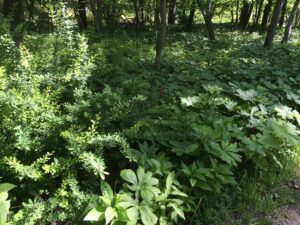
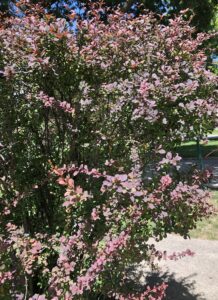
Why it’s a problem: Shades out understory plants.
Identification (from invasive.org):
- Appearance: Berberis thunbergii is a small deciduous shrub from 2-8 ft. (0.6-2.4 m) tall. The thin, grooved branches have thin, straight spines. Berberis thunbergii is very shade-tolerant and can form dense stands which shade out and displace native species.
- Foliage: The leaves are up to 1 in. (24 mm) long and paddle-shaped.
- Flowers: The pale-yellow flowers occur in drooping clusters of 2-5 and develop in mid-spring to early summer.
- Fruit: The berries ripen to a bright red color and are 0.25-0.3 in. (7-10 mm) long.
Images: Japanese barberry images
How it spreads: Seed dispersal by birds.
Callery Pear (Bradford pear), Pyrus calleryana
Why it’s a problem: Competes with native species. Prone to splitting. Widely planted ornamental.
Identification (from invasive.org):
- Appearance: Bradford pear is a cultivar of Pyrus calleryana. It is a deciduous tree that can grow up to 60 ft. (18 m) in height and 2 ft. (0.6 m) in diameter.
- Foliage: The leaves are alternate, simple, 2-3 in. (5.1-7.6 cm) long, petiolate, and shiny with wavy, slightly toothed margins.
- Flower: Flowering occurs early in the spring (April to May) before the leaves emerge. The flowers are 1 in. (2.5 cm) wide, showy, malodorous, and white. It is insect pollinated.
- Fruit: Fruits are round, 0.5 in. (1.3 cm) in diameter and green to brown in color.
Images: Callery pear images
How it spreads: Vegetatively. Seed dispersal by birds.
Common Buckthorn (Rhamnus cathartica) and Glossy Buckthorn (Frangula alnus)
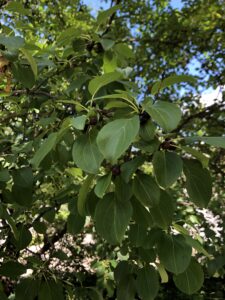
Why it’s a problem: Dense infestations in forests. Outcompetes native plants.
Identification (from invasive.org):
Common Buckthorn
- Appearance: Rhamnus cathartica is a deciduous shrub or small tree that can grow to 25 ft. (7.6 m) in height. The bark is dark gray and the inner bark is orange (easily seen when the tree is cut). Twigs are usually tipped with a sharp spine.
- Foliage: The leaf arrangement is usually sub-opposite, but examples of opposite and/or alternate arrangements are commonly found. Leaves are dark green, oval, 1.5-3 in. (3.8-7.6 cm) long, slightly serrate with 3 to 4 pairs of curving veins and a somewhat folded tip.
- Flowers: Flowering occurs in the spring, with fragrant, yellow-green, 4-petaled flowers developing in clusters of 2 to 6 near the base of the petioles. Plants are dioecious (male and female flowers occur on separate plants).
- Fruit: Appearing in the fall, the small, purple to black fruit are 0.25 in. (0.6 cm) in diameter. The fruit contains 3-4 seeds. Birds and other wildlife eat the fruit and disperse the seeds.
Glossy Buckthorn
- Appearance: Frangula alnus is a large shrub or small tree that can grow to heights of 30 ft. (9.1 m). Its bark is gray to brown with white lenticels.
- Foliage: The dark green leaves are shiny, alternate (sometimes opposite) and simple with prominent venation.
- Flowers: The flowers are inconspicuous, pale greenish-yellow to yellow in color and occur in clusters in the leaf axis. Flowering occurs from May through September.
- Fruit: The fleshy fruit ripens from red to a dark purple or black color. You can see ripe fruit beginning about July through September.
Images: glossy buckthorn, common buckthorn
How it spreads: Seed dispersal by birds.
Exotic Bush Honeysuckles
Amur honeysuckle, Tatarian honeysuckle, Bell’s honeysuckle, Morrow’s honeysuckle, Exotic Bush Honeysuckles, Invasive Exotic Shrub Honeysuckles
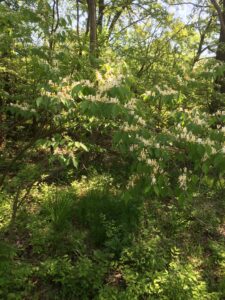
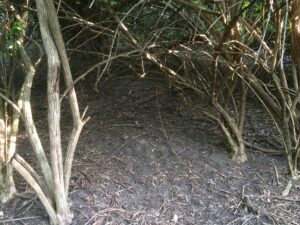
Why it’s a problem: Dense growth crowds out understory plants. Competes for pollinators with native honeysuckle species, poor food source for migratory birds, and contributes to long term forest decline.
Identification (from Exotic Bush Honeysuckles):
- Appearance: Exotic bush honeysuckles are upright, generally deciduous shrubs that range from 6 to 15 feet in height.
- Foliage: The 1-2 ½ inch, egg-shaped leaves are opposite along the stem and short-stalked. Older stems are often hollow.
- Flower: Pairs of fragrant, tubular flowers less than an inch long are borne along the stem in the leaf axils. Flower color varies from creamy white to pink or crimson in some varieties of Tartarian honeysuckle.
- Fruit: The fruits are red to orange, many-seeded berries.
- Note: Native bush honeysuckles may be confused with these exotic species and cultivars, so proper identification is necessary. Unlike the exotics, most of our native bush honeysuckles have solid stems.
Images: Amur honeysuckle, Lonicera maackii Dipsacales: Caprifoliaceae, Tatarian honeysuckle, Lonicera tatarica Dipsacales: Caprifoliaceae, showy fly honeysuckle, Bell’s honeysuckle, Lonicera x bella Dipsacales: Caprifoliaceae, Morrow’s honeysuckle, Lonicera morrowii Dipsacales: Caprifoliaceae
How it spreads: Seed dispersal by birds.
Winged burning bush, Euonymus alatus
Why it’s a problem: Dense infestations in forests. Outcompetes native plants.
Identification (from invasive.org):
- Appearance: Euonymus alatus is a deciduous shrub, up to 20 ft. (6.1 m) in height, which invades forests throughout the eastern United States. Two to four corky ridges often form along the length of young stems, though they may not appear in shaded areas or closed canopies.
- Foliage: The opposite, dark green leaves are < 2 in. (5 cm) long, smooth, rounded and taper at the tips. The leaves turn a bright crimson to purplish color in the fall.
- Flowers: The flowers are inconspicuous, are greenish yellow and have four petals. Flowers develop from late April to June and lay flat against the leaves.
- Fruit: The fruit which appears from September to October are reddish capsules that split to reveal orange fleshy seeds.
Images: winged burning bush images
How it spreads: Seed dispersal by birds.

